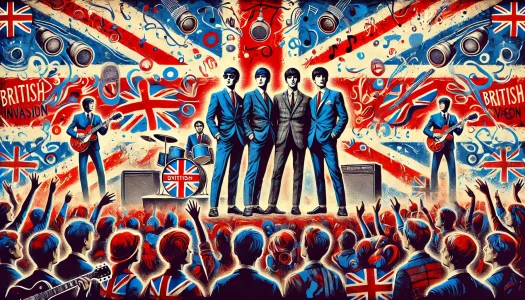On February 9, 1964, The Beatles made their iconic debut on The Ed Sullivan Show, marking a turning point in music and pop culture history. The broadcast reached over 73 million viewers—nearly half of the U.S. population—captivating audiences with the band’s infectious energy, harmonies, and charm. This performance wasn’t just a television event; it was a seismic cultural moment that introduced a new era of music and fandom to America.
The Beatles’ appearance on The Ed Sullivan Show is widely regarded as a milestone for several reasons. It served as the catalyst for the British Invasion, revolutionized the role of television in music promotion, and solidified rock and roll as a global phenomenon.
Setting the Stage: America Before The Beatles
In the early 1960s, the American music scene was in a transitional phase. Rock and roll, once electrified by pioneers like Elvis Presley and Chuck Berry, had begun to lose its edge. The charts were dominated by polished pop acts, such as The Four Seasons and Bobby Vinton, alongside the rising popularity of girl groups like The Shirelles and The Ronettes. While these artists enjoyed success, there was a noticeable absence of the rebellious spirit that had defined rock’s early days. Music was safe, formulaic, and largely domesticated.
This cultural lull coincided with one of the darkest moments in U.S. history: the assassination of President John F. Kennedy on November 22, 1963. The tragedy cast a shadow of grief and uncertainty across the nation, dampening the collective spirit of the American people. Amid this somber atmosphere, the country seemed primed for a cultural shift—one that could reawaken the vitality and optimism of a younger generation.
At the same time, the groundwork for that shift was quietly being laid. In the U.S., early British rock bands like The Shadows and The Tornados had gained modest recognition, sparking curiosity about the emerging music scene across the Atlantic. Yet, no group had managed to make a significant impact. The American public was on the cusp of discovering something fresh, dynamic, and thrilling—and it was into this environment that The Beatles arrived, poised to change everything.
The Historic Broadcast
On the evening of February 9, 1964, an estimated 73 million viewers—around 40% of the U.S. population at the time—gathered in front of their televisions to witness a phenomenon that would become etched in cultural memory. The Beatles took the stage on The Ed Sullivan Show with a setlist that showcased their versatility and charm, performing “All My Loving,” “Till There Was You,” “She Loves You,” “I Saw Her Standing There,” and “I Want to Hold Your Hand” across their segments. From the first notes of “All My Loving,” the band captivated the audience with their tight harmonies, infectious energy, and undeniable charisma.
The broadcast was as much about the visuals as it was about the music. The Beatles, dressed in matching tailored suits and sporting their now-iconic mop-top hairstyles, radiated a polished yet approachable image that instantly appealed to millions of young Americans. Close-up shots of Paul McCartney’s boyish grin, John Lennon’s cheeky confidence, George Harrison’s quiet cool, and Ringo Starr’s exuberance on the drums amplified their individual appeal. The audience—both in the studio and watching at home—was swept up in the wave of excitement, with young fans screaming in delight at every move the band made.
The immediate reaction was overwhelming. Critics lauded the performance, recognizing The Beatles as a fresh and innovative force in popular music. Fans were galvanized, sparking the phenomenon of “Beatlemania” in the U.S. seemingly overnight. Record stores sold out of Beatles albums within days, and radio stations played their songs in constant rotation.
Cultural Impact
This performance not only introduced The Beatles but also ignited the British Invasion, a cultural phenomenon that would reshape the American music landscape. British acts like The Rolling Stones, The Kinks, and The Who followed in their footsteps, flooding the U.S. charts and challenging the dominance of homegrown artists. The Beatles’ success opened the floodgates for a new era of transatlantic musical exchange, proving that British bands could thrive in the American market and influence global pop culture.
For American teenagers, The Beatles became more than just a band—they were an inspiration. Their performance sparked a cultural revolution that extended far beyond fandom. Teenagers across the country picked up guitars and formed garage bands, hoping to emulate their idols. The simplicity of The Beatles’ early songs made them accessible to aspiring musicians, while their creativity and innovation set a standard that encouraged experimentation. This surge of youthful creativity helped lay the foundation for the explosion of rock bands and countercultural movements later in the 1960s.
Closing Thoughts
The Beatles’ performance on The Ed Sullivan Show was an event of immediate and enduring significance. In the short term, it introduced a new sound and style to American audiences, sparking “Beatlemania” and catapulting the band to unparalleled global stardom. The broadcast marked the beginning of the British Invasion, forever altering the trajectory of the American music scene by shifting attention to a wave of British talent. It also demonstrated the power of television as a platform for shaping cultural phenomena, setting a precedent for music promotion in the decades to come.
In the long term, this singular event transformed the music and entertainment industry. The Beatles redefined the role of the artist, blending creativity, innovation, and mass appeal in a way that set new benchmarks for success. They inspired countless musicians to push boundaries and pursue their craft, fueling the creative explosion of the 1960s and beyond. Moreover, their appearance highlighted the potential for music to act as a unifying force, bridging continents and cultures through a shared love of sound.
